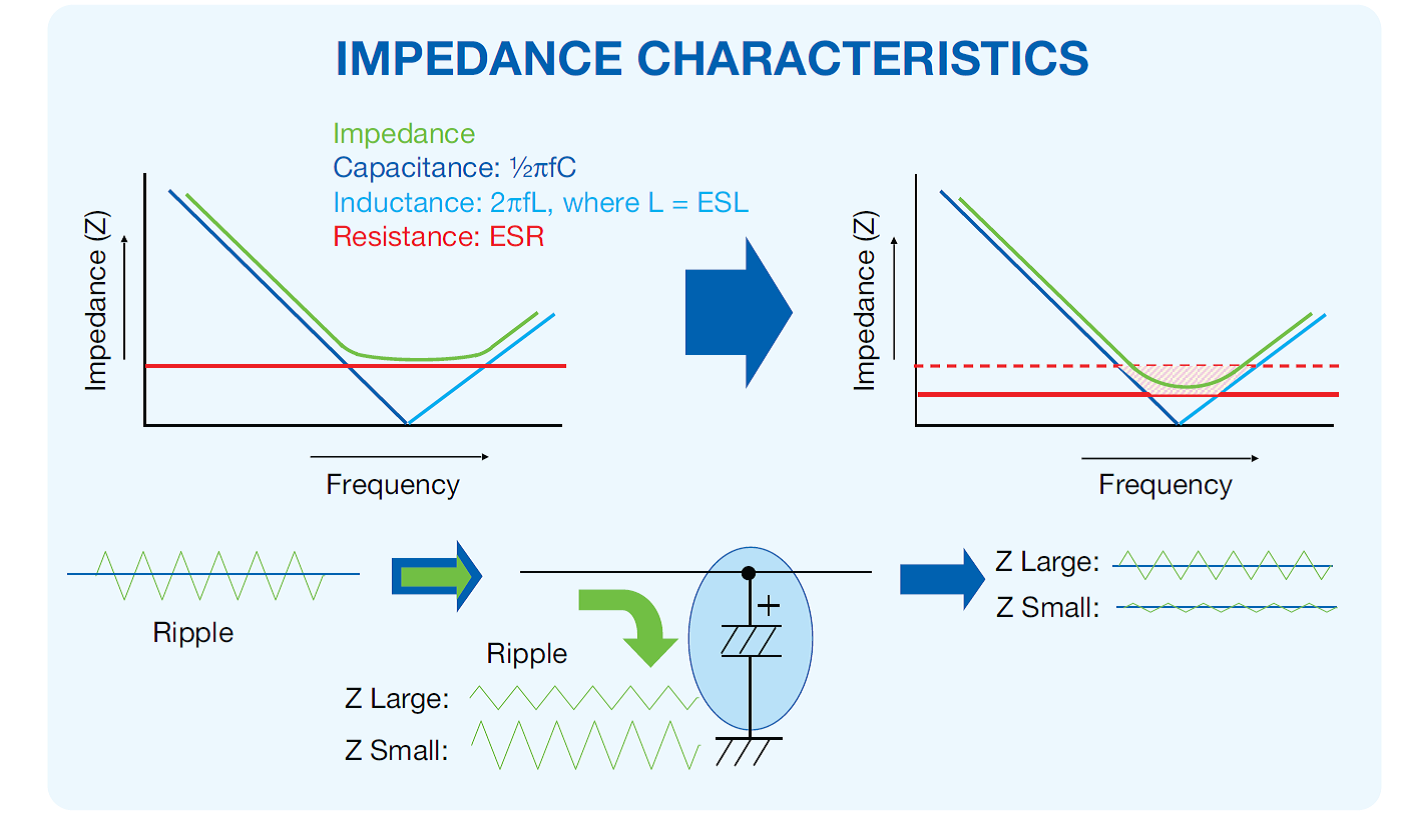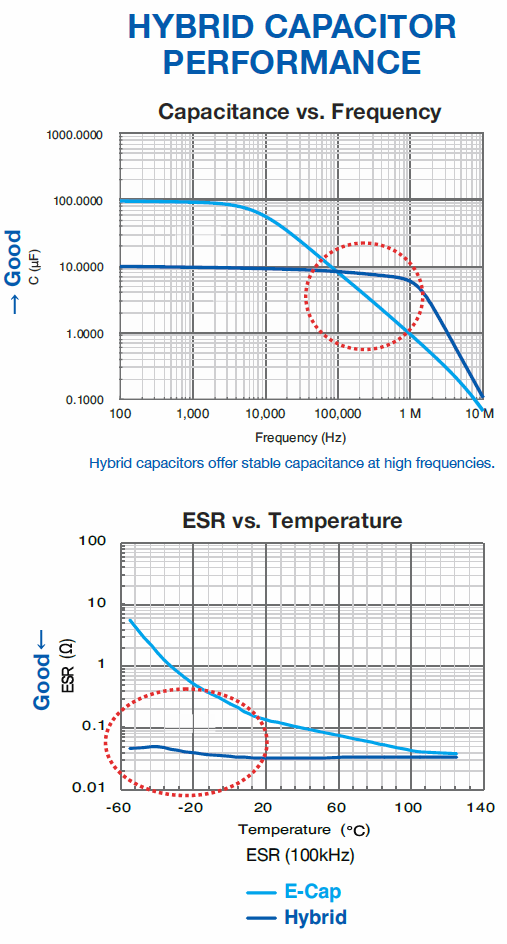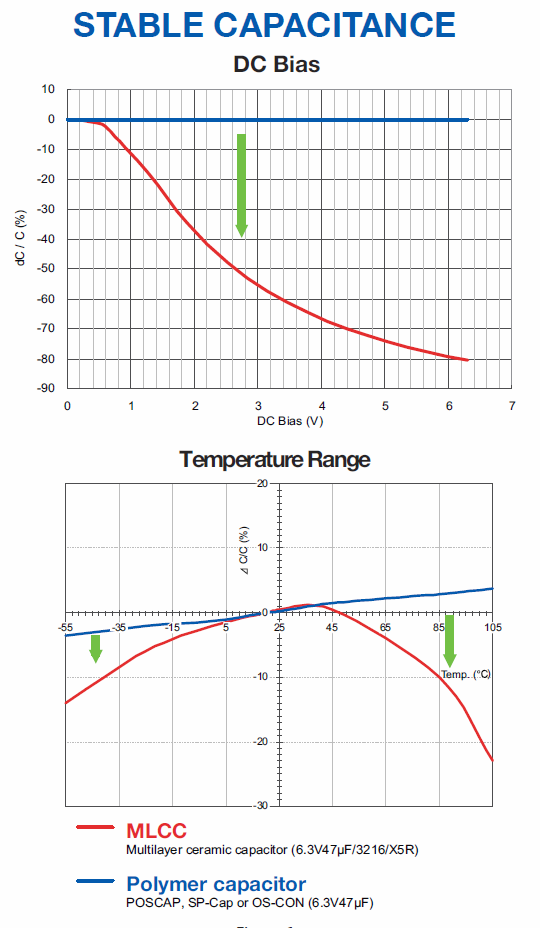Understanding polymer and hybrid capacitors
Capacitors may seem simple enough, but specifying them has actually grown more complex in recent years. The reason why comes down to freedom of choice. The universe of capacitors has expanded greatly over the past few years, in large part because of capacitor designs that take advantage of advances in conductive polymers.
These advanced capacitors sometimes use conductive polymers to form the entire electrolyte. Or the conductive polymers can be used in conjunction with a liquid electrolyte in a design known as a hybrid capacitor. Either way, these polymer-based capacitors offer a performance edge over conventional electrolytic and ceramic capacitors when it comes to:
- Electrical characteristics,
- Stability,
- Longevity,
- Reliability,
- Safety,
- Life cycle cost.
The various polymer and hybrid capacitors have distinct sweet spots in terms of their ideal voltages, frequency characteristics, environmental conditions and other application requirements. In this paper, we’ll show you how to identify the best uses for each type of advanced capacitor. We’ll also highlight specific applications in which a polymer or hybrid capacitor will outperform traditional electrolytic or even ceramic capacitors.
Layered polymer aluminium capacitors
These use conductive polymer as the electrolyte and have an aluminium cathode. Depending on the specific model, these capacitors cover a voltage range of 2-25V and offer capacitances of 2.2-560μF. The distinguishing electrical characteristic of these polymer capacitors is their extremely low equivalent series resistance (ESR). For example, some of our SP-Cap polymer capacitors have ESR values as low as 3mΩ, which is among the lowest in the industry. Packaged in a molded resin as compact surface mount devices, these layered polymer capacitors have a low profile. As a result of the electrical and form factor characteristics, they have applications in a variety of handheld electronic devices or other applications that require a low-profile capacitor that will not interfere with a nearby heat sink.

Figure 1
Wound polymer aluminium capacitors
These are also based on conductive polymers and aluminium, but they have a wound foil structure . The wound polymer capacitors cover a wider range of voltages and capacitance values than other types of polymer capacitors. Voltages cover 2.5-100V, while capacitances cover 3.3-2700μF. Like the layered polymer capacitors, the wound style has extremely low ESR values. Some of our OS-CON capacitors, for instance, have ESR values below 5mΩ. The wound style can also be surface mounted, though they are not quite as compact as the layered capacitors. Polymer tantalum capacitors employ a conductive polymer as the electrolyte and have a tantalum cathode. They span voltages of 1.8-35V and capacitances of 2.7-680μF. They, too, have low ESR values, with some of our POSCAP capacitors exhibiting ESR values as low as 5mΩ. Packaged in a molded resin case, the tantalum polymer capacitors are among the most compact on the market. Our POSCAP M size, for example, measures just 2.0x1.25mm. Though compact, a wide range of sizes is available for this capacitor type. Polymer hybrid aluminium capacitors. As their name suggests, these capacitors use a combination of a liquid and conductive polymer to serve as the electrolyte and aluminium as the cathode. Think of this technical approach as the best of both worlds: The polymer offers high conductivity - and a correspondingly low ESR. The liquid portion of the electrolyte, meanwhile, can withstand high voltages and provide higher capacitance ratings due to its large effective surface area. The hybrid capacitors offer a voltage range of 25-80V and capacitances of 10-330μF. At 20-120mΩ, ESR values for hybrids are higher than other types of polymer capacitors, but still very low considering the higher power applications they address.
Polymer capacitor advantages
Despite differences in their materials and construction, the four types of polymer capacitors share a collection of desirable electrical properties:
Great frequency characteristics: thanks to their ultra low ESR values, polymer capacitors have a low impedance near their resonance point (see Figure 1). And lower impedance reduces AC ripple in power circuits. Our testing has revealed as much as a fivefold reduction in peak-to-peak voltage changes when comparing polymer capacitors to conventional low-ESR tantalum capacitors.
Figure 2
Stable capacitance: with ceramic capacitors, capacitance drifts in response to temperature changes and DC bias. Polymer capacitors have no such problem and remain stable over time (see Figure 2). This stability is particularly important in industrial and automotive applications, which tend to experience fluctuations in operating temperatures. We’ve seen cases where elevated temperatures caused an effective capacitance loss of 90% or more for ceramic capacitors, meaning that the conventional capacitors deliver subpar performance in the field. Hybrid capacitors add another dimension to capacitance stability. They keep a stable capacitance in the face of common operating conditions - high frequencies and low temperatures - that reduce the capacitance of conventional liquid electrolytic capacitors (see Figure 3).
Enhanced safety: conventional electrolytic capacitors can suffer from safety issues that could cause them to short circuit and fail. The problem arises when electrical or mechanical stresses create defects or discontinuities in the oxide film that forms the capacitor’s dielectric. Polymer capacitors have a self-healing capability that eliminates this failure mode. The repair takes place in response to the joule heating that occurs when a dielectric defect triggers a short circuit. The heating breaks the molecular chain of the conductive polymer near the defect, driving up its resistance and effectively forming a barrier against any current leaking from the electrode. In the case of hybrid capacitors, an additional self-healing mechanism comes into play - because the liquid electrolyte causes current flow near the defect to reoxidise the aluminium. We have conducted numerous over-voltage tests to demonstrate the self-repairing nature of polymer and hybrid capacitors. One such test compared our SP-Cap polymer capacitors to a conventional tantalum-MnO2 capacitors. The polymer model withstood short currents as high as 7A, while the tantalum capacitor started smoking at 3A and ignited at 5A. This safety enhancement has important design and cost implications. Conventional tantalum capacitors are normally derated in use by 30 to 50% their labeled voltage to ensure that they operate safely. This derating, while a common and accepted engineering practice, results in an upsizing of capacitors and increased cost. For our polymer capacitors, by contrast, we guarantee operation at 90% of the full-rated voltage. Polymer capacitors have been in production since 1990. But they continue to evolve, both in terms of their electrical characteristics and their sizing. Consider our aluminium polymer capacitor line, for example. Upcoming models will drive ESR even lower and capacitance even higher - to 2mΩ and 680μF, respectively. Or looking at the tantalum polymer line, new models will offer reductions in ESR in smaller surface mount packages. For example, the 3.5x2.8mm B-Size capacitors will likely see a drop in ESR from 9 to 6mΩ.

Figure 3
Our hybrid capacitor line is evolving too. We are expanding the voltage coverage with new 16 and 100V capacitors. Life cycle and ripple current specifications are also slated for improvement in upcoming product releases.
These continuous technical improvements will make polymer and hybrid capacitors an increasingly attractive alternative to conventional tantalum-MnO2 and multi-layer ceramic capacitor (MLCC) technologies.




